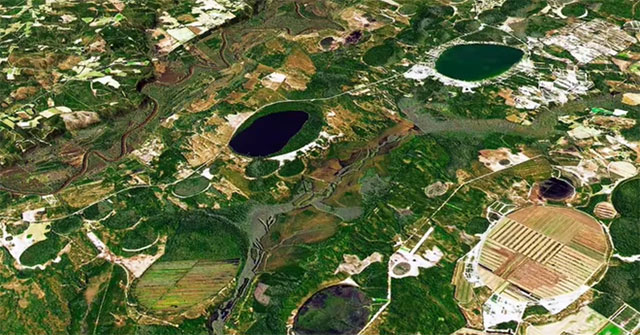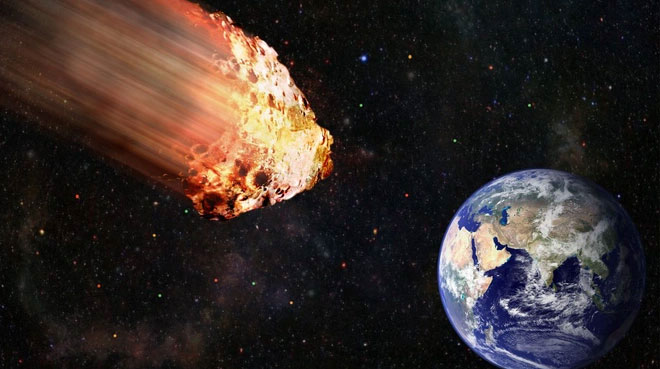Did aliens make up the mysterious Carolina Bays?
The Carolina Bay is just one example of the natural mysteries of the Earth that play an important role in the North American ecosystem, according to Assoc. Barrett appreciates as the gem of the American East.

This image, taken from NASA's Earth Observatory, shows several Carolina Bays near Bladen Lakes State Forest in North Carolina. Many places here are still ponds, although some have been depleted and used for agriculture (Image: NASA).
When the Wright brothers introduced mankind to the powered airplane at the turn of the 20th century, they not only provided us with a new way to travel, but also gave us a completely different view of what it is. things that still exist around, but are not taken care of.
And one of the areas that immediately attracted the attention of scientists and geologists was the Carolina Bay area.
According to the image observed from above, many flooded low-lying ponds can be seen along the coast from the two states of North and South Carolina, USA. By "a lot", we are talking about the number of hundreds of thousands of these strange geological samples, when they are distributed completely randomly and have no fixed size ratio.
"Carolina Bay is the name given to any wetland along the East Coastal Plain," said Kyle Barrett, Associate Professor of Wildlife Conservation at Clemson University. "They are elliptical in shape and are often isolated from other bodies of water, such as streams or rivers."
An obvious feature is that the Carolina Bays are located in low geographical locations, so they are often filled by rain, but can also be drought during hot and dry times of the year.
Answers from ancient times

The meteor shower was once thought to be responsible for the formation of hundreds of thousands of Carolina Bays stretching along the beach
In 1950, it was hypothesized that a violent meteor shower might have formed the Carolina Bays. To uncover the true origins of the unusual geologic regions, scientists conducted radiocarbon dating of buried organic deposits.
However, the results really surprised them. It turns out that not all of the Carolina Bays were formed at the same time. Some of them were formed tens of thousands of years apart.
"Some wetlands are estimated to be more than 100,000 years old, while others are only 15,000 years old or less," said Assoc. Kyle Barrett said.
This age difference led scientists to immediately believe that the Gulfs were not caused by meteor showers, because if they were, they would be about the same age.
In addition, no material has been found in the soil suggesting extraterrestrial formation. This has crushed the conspiracy theories of those who believe in UFOs, and that this is a "launching ground" of aliens from before man knew.
Wind is the second hypothesis put forward, and has convinced some geologists.
It is thought that at the end of the Pleistocene (2.5 million years ago), the southwest wind blew very strongly to this area, forming natural flows, running along the southwest and northwest. Over time, they formed what we now call Carolina Bay.
Although there is no concrete evidence to prove this, the wind hypothesis is still considered the most reliable.

The most likely hypothesis for how the Carolinas were formed is that winds created the currents millions of years ago (area in blue).
The Disappearance of the North American Ecosystem
According to scientific documents, at one point, there may have been as many as 200,000 Carolina Bays in this area. Yet researchers say that nearly 97 percent of the Carolina Bay has been affected by indigenous agriculture and logging.
Human impact has not only erased part of our geological past, but also disrupted a swampy ecosystem important to many wetland species such as salamanders and frogs in North America.
"The Carolina Bays, along with other isolated wetlands, offer many environmental benefits," explains Barrett. "Even terrestrial species, such as birds and bats, are more abundant in forests that include the Carolina Bay than in forests of the same size."
Wetlands like the Carolina Bay are also essential in preventing flooding and improving water quality. Unfortunately, many Bays have been substituted for human uses such as farmland, house construction, occupancy, or expansion into ponds.
Barrett says that any wetland that is not near a permanent stream or river is not protected by the Clean Water Act (CWA). This makes the exploitation of the Carolina Bays increase over time.

Lake Waccamaw is a 2,400-acre (971 ha) Carolina Bay in North Carolina. This is the habitat of aquatic species that cannot be found anywhere else on Earth
"Gem" of the American East
The Carolina Bay is just one example of the natural mysteries of the Earth that play an important role in the North American ecosystem, according to Assoc. Barrett appreciates as the gem of the American East.
"When land is filled in on grasslands or crops, it not only takes away important wetlands of habitat; it also disrupts the balance of water flow and natural flood protection systems. This has harmed the living environment and our own livelihood", Assoc. Barrett said.
Without these wetland environments, we would be missing out on some of the most complex biodiversity ecosystems in North America, such as the diversity of amphibians and reptile.
In addition, Carolina Bay is also recorded as the habitat of more than 25 species of extremely diverse and abundant carnivorous plants. Of these, some species are found only in the marshes of the Carolina Bay.
- UFO appear in the state of North Carolina of America?
- Mysterious people dressed in black protect the aliens
- The most mysterious kidnappings of UFOs ever recorded
- The appearance and costumes of aliens
- UFOs, aliens - the century of humanity
- Discovering strange sea creatures suspected of being aliens in America
- Disclosure of aliens' autopsies
- Obtain a mysterious signal of aliens
- 10 suspicious objects related to aliens
- Find radio waves to detect aliens
- The mysterious events to shudder are real but there is no solution
- Mysterious aliens in epic Gilgamesh
 'Fine laughs' - Scary and painful torture in ancient times
'Fine laughs' - Scary and painful torture in ancient times The sequence of numbers 142857 of the Egyptian pyramids is known as the strangest number in the world - Why?
The sequence of numbers 142857 of the Egyptian pyramids is known as the strangest number in the world - Why? History of the iron
History of the iron What is alum?
What is alum?